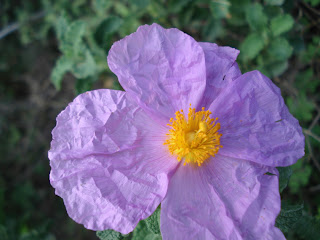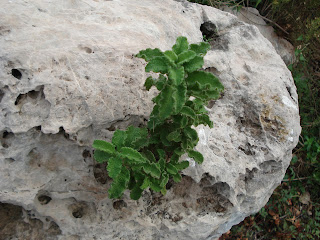Description: Labdanum resin originates from the rockrose bush, which exudes a resinous dark brown mass from its leaves and twigs. To this day it's still gathered by driving goats into the thick forests overgrown with rock rose bushes. The goats eat their fill from the branches and the sticky resin gets stuck on their beards and hides. When they return, their owners carefully comb the resin off each goat. Also used is a rake-like instrument with long strips of leather attached to it, which they drag across the bushes to collect the resin.
Labdanum has fascinated peo ple for many centuries.Ancient Egyptians used it in their Kyphi incense mixtures and the Hebrews burned it in their temples. It's said to reach deep into our subconscious and bring back memories, feelings, and moods.
Labdanum is widely treasured in the perfume industry as a fixative and ambergris substitute. It's also used in the leather trade to add aroma to hides.
Family: Cistaceae
Synonyms: Rock Rose resin, Sun Rose resin
Parts Used: oleo gum resin
Aroma Description: very complex - rich, balsamic, woody, earthy, marshy, smoky, ambergris, leathery, sweet, flowery, honey, mint fragrance with hints of plum or oak moss after a rain.
Emotional Attributes: strengthening, creativity, relaxation, meditation, sensuous, love
Cosmetic Uses: perfumery, aromatherapy
Culinary Uses: commercial food flavoring for baked goods, soft drinks, ice cream, and candy.
Medicinal Attributes: stimulant, expectorant, with anti-biotic effects. Used to treat diarrhea, and excess mucus.
Element Association: Fire
Magical Associations: spirituality, protection, courage
Astrological Association: Libra, Scorpio, Cancer
Planetary Association: Moon, Mars, Jupiter
Season: Summer, Autumn
Aromatic Note: Base note
Essential Oil: Yes, steam distilled. An absolute is also available, extracted using solvents and alcohol. Labdanum oil, also called Cistus oil, is a very important fixative oil for the perfume industry and also provides them an ambergris and musk oil replacement or enhancer. A different Cistus oil is made from the leaves of the same plant.
Mixes Well With: amber, bay laurel, calamus, cardamom, chamomile, copal-black, iris root, lavender, musk seed, nutmeg, oakmoss, opoponax, patchouli, rosemary, rose, saffron, sandalwood, spikenard, storax, tolu balsam, turmeric, etc.
Incense Use Tip: Use rubber or latex gloves!!! This resin is soft, sticky, and tar-like. It's much easier to use if it's first frozen. Freeze the resin for 1 hour or longer to harden it for grinding in a mortar and pestle. You can also carefully use a knife to shave pieces off the edges of the frozen resin.
A seldom used alternative is to warm the labdanum resin to a pour-able state, which enables you to drizzle it into a loose incense mixture. Warm it by placing labdanum resin in a glass jar, seal it and sit the jar in hot water until resin is more liquid-like and pour-able. A double-boiler may be required.
In either case, we highly recommend using rubber or latex gloves and a well covered disposable work area for easy cleanup of this very sticky resin. It can create quite a sticky mess!






















